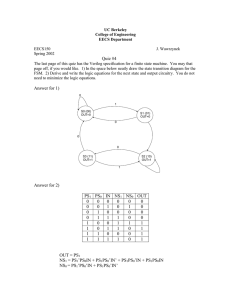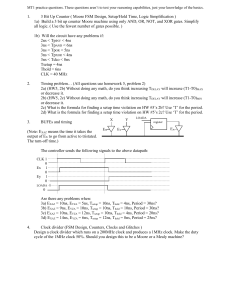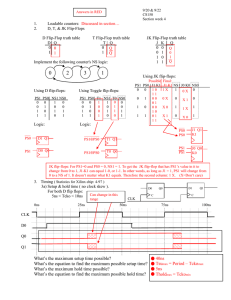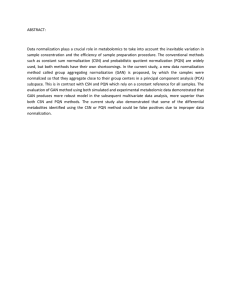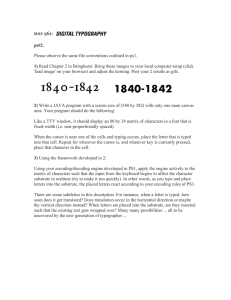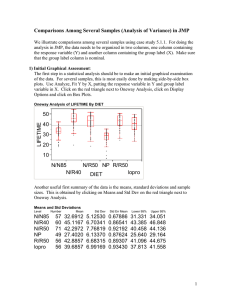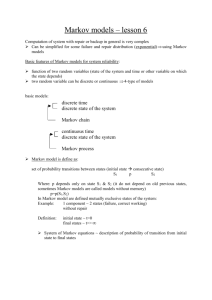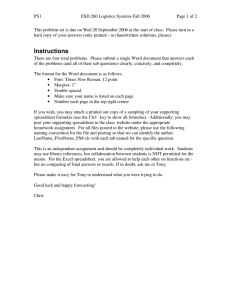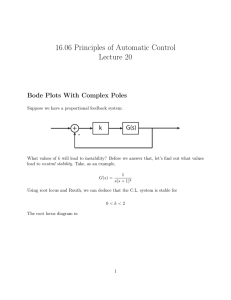Midterm 1 practice problems ( In Word!!!!! )
advertisement
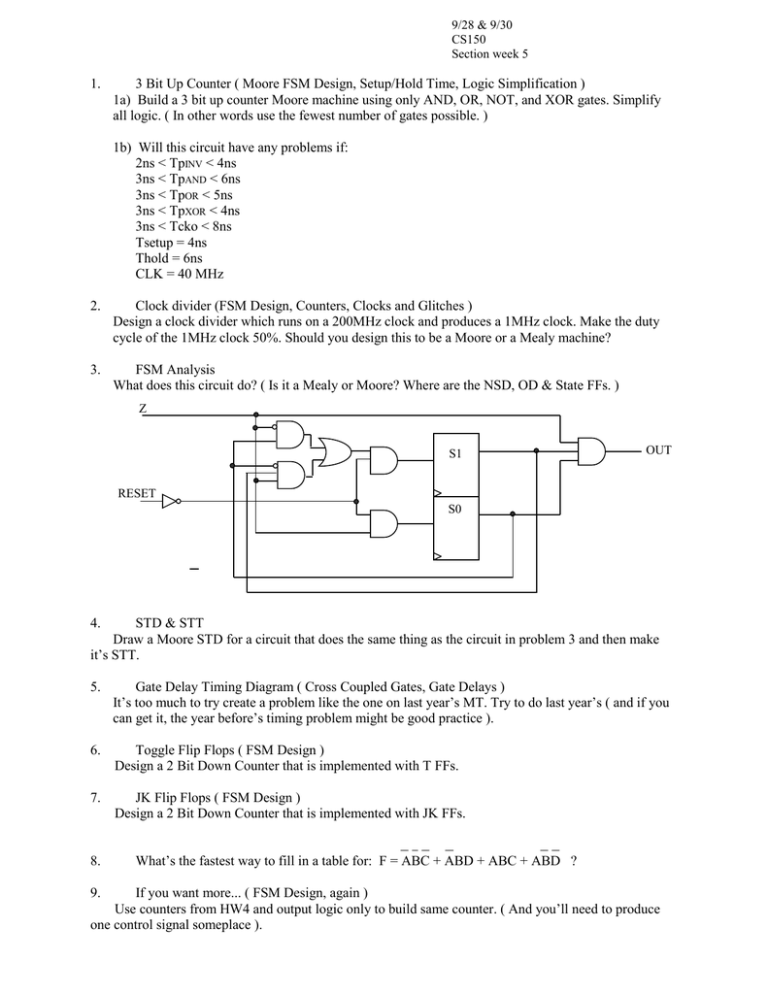
9/28 & 9/30 CS150 Section week 5 1. 3 Bit Up Counter ( Moore FSM Design, Setup/Hold Time, Logic Simplification ) 1a) Build a 3 bit up counter Moore machine using only AND, OR, NOT, and XOR gates. Simplify all logic. ( In other words use the fewest number of gates possible. ) 1b) Will this circuit have any problems if: 2ns < TpINV < 4ns 3ns < TpAND < 6ns 3ns < TpOR < 5ns 3ns < TpXOR < 4ns 3ns < Tcko < 8ns Tsetup = 4ns Thold = 6ns CLK = 40 MHz 2. Clock divider (FSM Design, Counters, Clocks and Glitches ) Design a clock divider which runs on a 200MHz clock and produces a 1MHz clock. Make the duty cycle of the 1MHz clock 50%. Should you design this to be a Moore or a Mealy machine? 3. FSM Analysis What does this circuit do? ( Is it a Mealy or Moore? Where are the NSD, OD & State FFs. ) Z S1 OUT RESET S0 4. STD & STT Draw a Moore STD for a circuit that does the same thing as the circuit in problem 3 and then make it’s STT. 5. Gate Delay Timing Diagram ( Cross Coupled Gates, Gate Delays ) It’s too much to try create a problem like the one on last year’s MT. Try to do last year’s ( and if you can get it, the year before’s timing problem might be good practice ). 6. Toggle Flip Flops ( FSM Design ) Design a 2 Bit Down Counter that is implemented with T FFs. 7. JK Flip Flops ( FSM Design ) Design a 2 Bit Down Counter that is implemented with JK FFs. 8. 9. What’s the fastest way to fill in a table for: F = ABC + ABD + ABC + ABD ? If you want more... ( FSM Design, again ) Use counters from HW4 and output logic only to build same counter. ( And you’ll need to produce one control signal someplace ). Solutions: 1. a) STT: PS2 0 0 0 0 1 1 1 1 PS1 0 0 1 1 0 0 1 1 PS0 0 1 0 1 0 1 0 1 NS2 0 0 0 1 1 1 1 0 NS1 0 1 1 0 0 1 1 0 NS0 1 0 1 0 1 0 1 0 b) Equations: NS0 = PS0 NS1 = PS1 PS0 NS2 = PS2 PS0 + PS2 PS1 + PS2 PS1 PS0 c) Any problems? Check for hold time violations ( Can value from flip flop output propogate back to the flip flop input so quickly that the hold time is violated? ): > Find the shortest propogation path: Looks like NS0 ( XOR gates have bigger delay than inverters ). ? Tckpmin + Tinvmin > Thold ? 3ns + 2ns > 6ns This isn’t true hold time violation possible. Check for setup time violations ( Can value from flip flop output propogate back to the flip flop input so slowly that the next clock’s setup time is violated? ) > Find the longest propogation path: Looks like NS2. ? Tckomax + Tinvmax + Tandmax + Tormax + Tsetup ?< Period ( 1/40MHz = 25ns ) 8ns + 4ns + 6ns + 5ns + 4ns < 25ns False setup time violation possible. This should be a Moore machine with two states and no logic on the output – the output should come directly from the state bits. Because... any combinational logic, no matter how simple may cause glitches. It should change states when a counter counts up to 100. Since the output of this circuit is a clock, we have to make especially sure that there aren’t glitches on the output. Moore is safer than a Maely in this case. Why? It’s a Mealy pattern detector ( 1011 ). Equations: RESET PS1 PS0 Z NS1 NS0 NS1 = R ( PS0 Z + PS1 PS0 Z ) 0 0 0 0 0 0 0 0 0 1 0 1 NS0 = Z R 0 0 1 0 1 0 OUT = Z PS1 PS0 2. 3. STT: STD: RESET 1/0 00 0/0 0/0 01 1/0 1/0 10 11 0/0 0/0 1/1 0 0 0 0 0 1 1 1 1 1 1 1 1 0 1 1 1 1 0 0 0 0 1 1 1 1 1 0 0 1 1 0 0 1 1 0 0 1 1 1 0 1 0 1 0 1 0 1 0 1 0 1 0 0 1 1 0 0 0 0 0 0 0 0 0 1 0 1 0 1 0 0 0 0 0 0 0 0 OUT 0 0 0 0 0 0 0 1 0 0 0 0 0 0 0 1 4. The Moore STD has 5 states. 1 is output in the 5th state. On the STT, make sure that the output is the same for the same PS even though the input changes. 5. ------ 6. STT: PS1 0 0 1 1 7. Equations found for T1 and T0: Bookkeeping PS0 0 1 0 1 T1 0 1 0 1 T0 1 1 1 1 NS1 0 1 1 0 NS0 1 0 1 0 STT: Bookkeeping PS1 0 0 1 1 PS0 0 1 0 1 J1K1 0X 1X X0 X1 X means “don’t care”. J0K0 1X X1 1X X1 NS1 0 1 1 0 OUT1 1 Equations: J1 = PS0 K1 = PS0 J0 = PS0 NS0 1 K0 = PS0 0 1 0 T1 Q1 T0 Q0 OUT0
